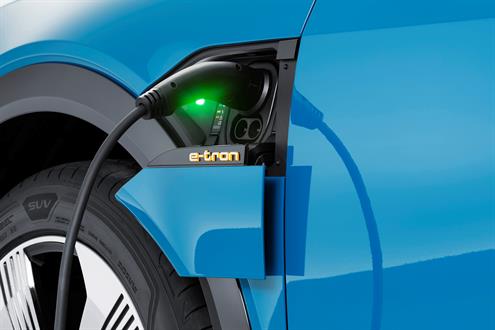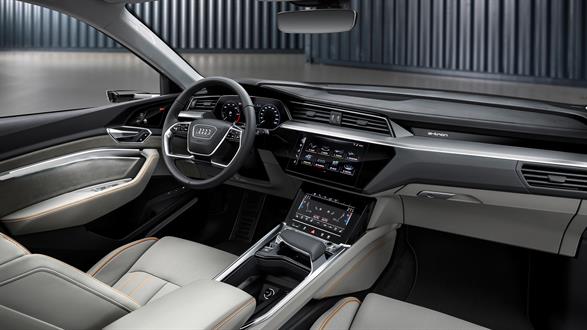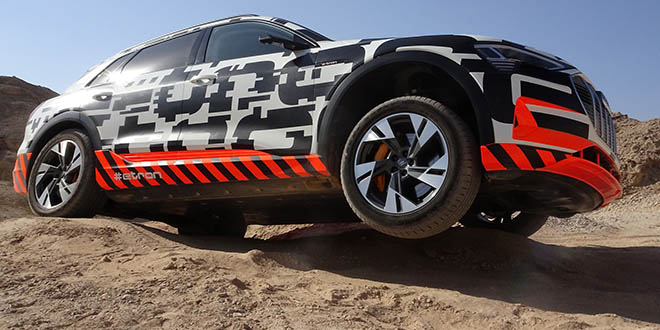Alright, whose bright idea was in to launch Audi’s first electric car in the oil state of Abu Dhabi? Either someone was having a laugh or there was a real sense of irony behind the choice.
I’ve never been to the United Arab Emirates, or indeed anywhere near this part of the world, so it was quite a culture shock to see the city for the first time.
Everywhere you go, you can see signs of serious money having being spent. You get the impression that if you came back again in five years, any scrap of desert you see would have another skyscraper built on it.
The Sheikh Zayed Mosque, in the heart of the city, in my view is one of the wonders of the world. Completed only 2007, it contains €30 billion of white marble and if you ever get the chance to see it, grab it with both hands.

Now, we’ve seen many Audi e-trons at various motor shows and e-tron is the name Audi gives to their range of plug-in hybrids. This e-tron though is Audi’s first production electric car and it’s a serious statement of intent as it’s a purpose built SUV with very few compromises in performance.
It’s built on a new MEB electric car platform which allows the battery to be mounted on the floor of the car, the classic ‘skateboard’ configuration for a proper electric car.
The battery actually forms part of the floor and the flush underbody does great things for the airflow around the car, which is notably slippery, particularly for an SUV.
It’s a good job that he battery is mounted low down as it makes up a considerable portion of the car’s 2,500kg weight. It’s a 95kWh unit which weighs a whopping 700kg, but that’s enough for a range of over 400km.
There are two motors in the e-tron, one in the front and one in the back, which conveniently provide a quattro four wheel drive system. Together, the two produce 300kW of power and 664Nm of torque. Performance is very strong, with 0-100km/h coming up in 5.7 seconds and a top speed limited to 200km/h.
Of course, with the instant torque provided by the electric powertrain, performance seems even more impressive, the car responding instantly to any input from the throttle.

With that big battery, hooking the car up to a three pin plug is going to be an exercise in frustration so the Audi supports fast charging, up to 150kW DC, which is faster than anything else on the market.
We don’t even have chargers this powerful yet, although Audi plan to start installing them and will offer e-tron owners a single account allowing access to a number of charging solutions. Smart cards eventually won’t be needed as the car itself will identify itself to the charger.
We saw one of these fast chargers in operation and while it’s capable of giving an 80% charge in around half an hour, it generates some serious heat while doing so, emphasising just how much power is pumped through in such a short time.
Despite being a city built on oil reserves, Abu Dhabi seem to be thinking of the future and their energy requirements in years to come. They’ve built a low-carbon city from scratch, Masdar city, which is powered entirely by green electricity, generated by wind, tide or sun. To emphasise the green credentials of the e-tron, it was here that we started out on our test route.
So how does the e-tron drive? Well just like a normal SUV, except in almost total silence. For efficiency reasons, most of the power is sent to the rear motor in normal driving conditions with the front being brought in when needed. Wheel slip and grip are monitored around 20 times a second and the torque going to either end can be adjusted as necessary even before the wheels slip.

We got the chance to really put the e-tron through its paces in the heart of the desert around Abu Dhabi.
We had the opportunity to try the car on an off-road course in the desert and it dealt impressively with everything we threw at it. Of course, in the desert, we had no mud to deal with but the rocks and sand under our wheels were enough of a challenge. At the half way point, we got out for a few minutes to experience the searing heat and afterwards it was a great relief to regain the air conditioned comfort of the e-tron and note that we had plenty of power left in the battery to get back to civilisation.
Most of our driving was done on smooth roads, which stretched out into sandy wastelands. At some points, these were derestricted to 160km/h so we had the chance to stretch our legs and the e-tron was smooth and stable while remaining incredibly quiet.
Some of that quietness came from the aerodynamics, with the best configurations posting an impressive figure of 0.27. To achieve this, the normal door mirrors are replaced by tiny high definition cameras which transmit their images onto an OLED screen at the top of the door. To be honest, I hated them. They’re much smaller than a conventional mirror, much dimmer and I really couldn’t trust what I was seeing, particularly when reversing. I was continually looking in the wrong place when I needed to check the mirror quickly and I found they were very distracting as a result. I wasn’t alone in my ambivalence towards these but they might suit an owner who wants to really be on the leading edge. For me, I’d happily spec normal mirrors happy in the knowledge that the superior aerodynamics of the cameras only contribute 2km to the total range.
We also had the chance to try one of the most famous roads in the world, the Jebel Hafeet Mountain Road, with 7km of beautiful twists and turns up a mountain road essentially leading nowhere. The ultimate folly you could call it.
Despite the very low speed limit, we drove up the road in a very spirited manner and as a consequence used up a lot of the available range. On the way back down, the e-tron’s regenerative braking took over and gave us back quite a percentage of that power. In normal usage, up to 30% of the total range comes from the regeneration system, which can be controlled with the steering wheel paddles. At up to 0.3g braking, only the motors are used to slow the car with the conventional brakes only brought into play for more severe braking.

As for the rest, the e-tron is a practical, five seater SUV with Audi’s usual impressive cockpit. There’s 600 litres of luggage space in the back and a further 60 litres in a compartment in the bonnet, although this is taken up with the various charging leads and an emergency puncture kit.
E-tron pricing starts at €101,750 (ex Government grants) and first deliveries will start early this year. The initial cars are expected to be launch editions with a very high level of specification (including those mirrors). LED headlights will feature as standard with matrix LED available from the middle of the year. Irish cars will also get a charging socket on both sides of the car. Mounted on the front wings, the flap covering the socket opens and closes automatically under electric power. It’s a very cool feature.
Audi’s virtual cockpit will be standard and an optional virtual cockpit plus adds a third screen for the electric drive system, although I felt even more information could be made available. At least the range is calculated accurately using data from radar, cameras and the navigation system with the last 150km of driving being taken into account.
The e-tron is a proper electric SUV from a recognised manufacturer and as such, it’s a major development in the journey towards electrification.
Motoring editor - The Clare Champion
Former Chairman and voting member of Irish Motoring Writers' Association


